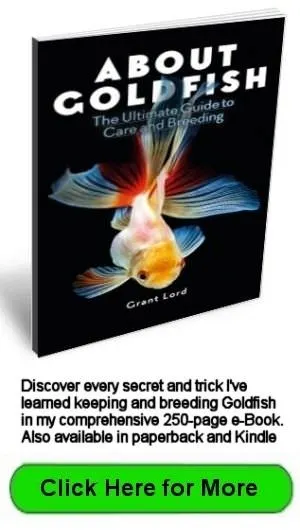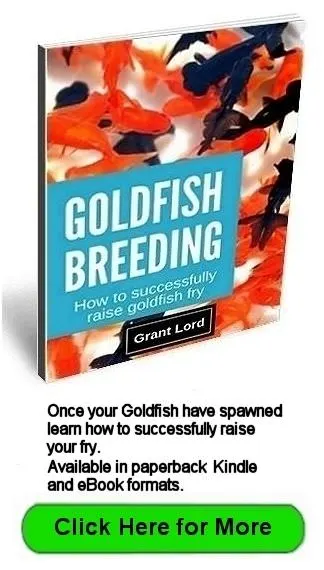- Home
- Aquarium Plants
Goldfish and Aquarium Plants
Goldfish are avid plant eaters but, there are aquatic plants that can resist their attacks.
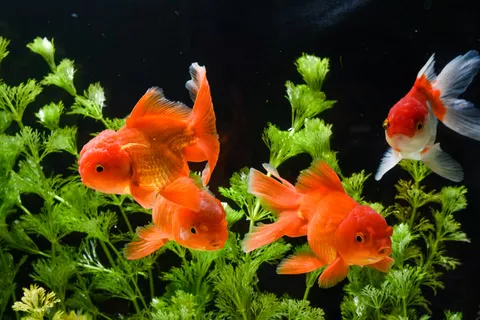 Goldfish and plants featuring in a typical planted aquarium.
Goldfish and plants featuring in a typical planted aquarium.Introduction to Aquarium Plants for Goldfish
Goldfish and plants aren't a good combination. Goldfish are omnivorous and consider aquatic aquarium plants food that helps fill their dietary requirements. It is very frustrating planting up an aquarium only to find a few stems left the following day.
If Goldfish are fed lightly during spring and autumn they are more likely to attack aquarium plants.
Plant eating can be quite fickle; one group of Goldfish will devour certain plants, while others will completely ignore them, duckweed is a prime example.
There are plants that
I found resistant to their attacks
through trial and error when hiring aquariums.
Last Updated: 11-14-2024 by Grant Lord.
Plant Selection Criteria
Plants have different uses in the aquarium.
Some are used to hide filter equipment in the aquarium, others grow quickly, some are very good at nutrient absorption (nitrates), and others are used purely for ascetic reasons.
Plants can be divided into background, foreground, or visual interest plants. Some plants are suitable as food to fill dietary needs.
Background Plants
Vallisneria (Eelgrass, tape grass)
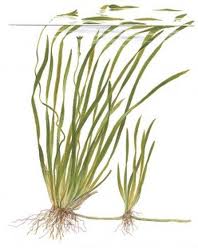 Vallisneria
Vallisneria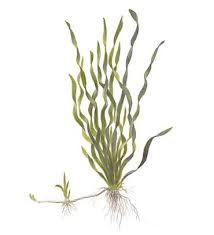 Corkscrew Vallisneria
Corkscrew VallisneriaOne of the more popular aquarium plants, these tall, fast-growing plants are used in the background as they are useful for hiding filter plumbing.
The leaves are tough and strong, so herbivorous fish do not usually eat them. This plant is easy to propagate using runners, which are prolific if the substrate provides sufficient food.
In the recent past, there has been confusion regarding what species of Vallisneria exist and what varieties come under each species.
In 1982, two independent botanists came to the same conclusion; there are only two species:
- V.Americana and
- V.Spiralis. The term spiralis refers to the long spiraling stalk of the female flower that reaches upwards to the water surface, not the shape of the leaves.
Both species have two varieties, one that grows its leaves in a corkscrew shape and the other in flat ribbon-like leaves. There are several hybrids and variants available.
The most common varieties used are:
- Corkscrew Vallisneria. The leaves of these varieties grow in the form of a corkscrew and grow 30-50cm (12-20 inches) in length. Some newer dwarf varieties only grow 15cm (6") tall.
- Giant Vallisneria. The leaves can grow 180cm (6 feet) long, so this variety is more suited to very tall aquariums or deep ponds.
- V.Americana or V.Spiralis with flat ribbon-like leaves, hence the name tape grass. The most commonly used form with the leaves reaching between 90-120cm (3-4 feet) long.
Vallisneria has a pH tolerance of 6-9.5. Temperature range 20-28oC (68-82oF).
Hygrophila Difformis (Water Wisteria)
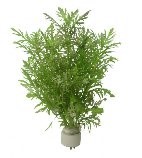 Hygrophila Difformis
Hygrophila DifformisSuitable as a background plant for shorter aquariums.
Fast growth helps prevent algae because the plant absorbs a large amount of nutrients from the water. It tolerates lower light levels, but higher light conditions lead to enormous growth rates.
A shortage of micro-nutrients leads to pale leaves, which may indicate that the aquarium needs fertilizer. It has a pH tolerance of 5-9.
Temperature range 18-30oC (64-86oF).
Foreground Plants
Blue Hygrophila
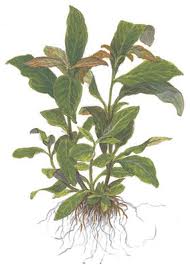 Blue Hygrophila
Blue HygrophilaThis plant is mainly used as a foreground plant. It is a bog plant that can adapt to complete immersion in water. It is sold as a cutting. It is a fast-growing plant in good light conditions and an algae-free environment.
Under ideal conditions, it can grow to the top of the aquarium. Goldfish often chew the leaves during spring and autumn or if they are very hungry. It tolerates wide pH and temperature ranges.
Plants for Visual Interest
Ludwigia Arcuata
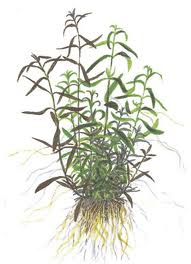 Ludwidia Arcuata
Ludwidia ArcuataUsed for creating interest. It requires a relatively large amount of light before forming a red stem and leaves. It thrives best in slightly acidic water.
The most decorative effect can be achieved by planting it in groups.
PH range 5.5-8.0,
Temperature range 20-28oC (68-82oF).
Red Hygrophila
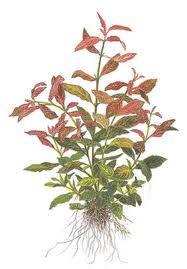 Red Hygrophila
Red HygrophilaAgain, it is used to create interest. This plant comes from South America and is a marsh plant.
It is slow-growing and needs algae-free conditions to prosper. It is hard to propagate from a cutting, has a soft, delicate stem that is easily bruised, and can quickly rot back even though it has been planted with a rooting node.
It needs good light. The cuttings start green on top and red underneath, but the new leaves are ruby red and very decorative.
PH range 5.0-8.0, Temperature range 22-26oC (72-79oF).
Red Bacopa
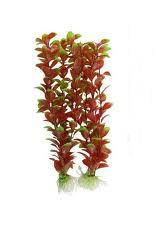 Red Bacopa
Red BacopaAgain, it is used to create interest. The plant comes from the Southern USA and Central America. Its leaves are quite fragrant. Cultivation is done by rooting stem cuttings. It requires good light and an algae-free environment.
Goldfish will generally not chew on this plant. The leaves, completely green initially, get quite a red tinge to the underside.
Its tolerance levels for pH and temperature are well within the levels experienced in the aquarium.
Plants Suitable As Goldfish Food
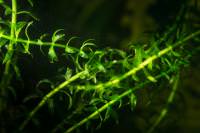 Elodea Crispa
Elodea CrispaIf you want to treat your Goldfish or increase green matter in their diet, use Elodea Crispa or Elodea Canadensis, also known as oxygen weed. They love it!
It will grow when free-floating but it grows more vigorously if it is rooted in substrate.
Tolerates lower water temperatures 7-24oC (45-75oF).
Conclusion
There is quite a selection of plants that will resist hungry Goldfish, it is just a matter of deciding what you want to use the plant for, hiding unsightly equipment, aesthetics, or functional benefits.
Keep in mind the Goldfish variety you own or are planning to keep. Some fancy varieties, such as Celestials or Water Bubble Eyes and Moors, will have difficulty navigating a heavily planted aquarium.
